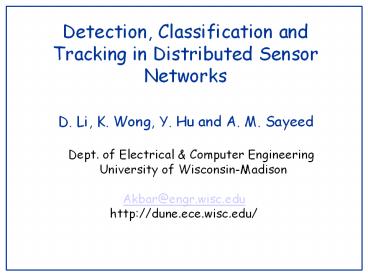Detection, Classification and Tracking in Distributed Sensor Networks
Title:
Detection, Classification and Tracking in Distributed Sensor Networks
Description:
Initialization: Put all locations where vehicle can enter (in this case the ... Wheeled. Tracked. Unknown. Some Issues and Challenges. Variability in ... –
Number of Views:27
Avg rating:3.0/5.0
Title: Detection, Classification and Tracking in Distributed Sensor Networks
1
Detection, Classification and Tracking in
Distributed Sensor Networks
D. Li, K. Wong, Y. Hu and A. M. Sayeed
Dept. of Electrical Computer
Engineering University of
Wisconsin-Madison Akbar_at_engr.wisc.edu
http//dune.ece.wisc.edu/
2
Overview
- -Small, densely distributed wireless sensors.
- -Collaboration necessary for tracking and
classification, but not for detection. - -Multi-modal sensors (potentially)
- -Tracking vehicles (tanks, trucks).
3
Space-Time Sampling
- Sensors sample the spatial signal field in a
particular modality (e.g., acoustic) - Sensor density commensurate with spatial signal
variation - Sampling of time series from each sensor
commensurate with signal bandwidth - Signal field decomposed into space-time cells to
enable distributed signal processing
Space
Space
Time
Time
Uniform space-time cells
Non-uniform space-time cells
A moving object corresponds to a spatial peak
moving with time Target tracking corresponds to
determining the peak location over time
4
Detection
- Simple energy detector
- detect a target/event when the output exceeds a
threshold - Otherwise, update the threshold.
- Detector output
- at any instant is the average energy in a
certain window is sampled at a certain rate based
on a priori estimate of target velocity
5
Target Localization at a Time Instant
- CPA/Energy based
- Location of the sensor with largest output
- Using attenuation exponent and 4 or more sensor
measurements.
6
(No Transcript)
7
Single Target Tracking
- Initialization Put all locations where vehicle
can enter (in this case the corners) onto
detection alert. - Three-step procedure
- A track is initiated when a target is detected in
a region - Target locations are estimated for N successive
time instants. These positions are used to
predict target location at MltN future instants - Predicted positions are used to create new
regions that are put on detection alert
8
Multiple Targets
- Can track multiple targets if they are
sufficiently separated in space and/or time - separate track for each target
- Can track spatio-temporally overlapping targets
with appropriate classification algorithms
9
Classification
- Three types of classifiers under investigation
- K-nearest neighbor (KNN)
- Maximum likelihood (ML) (Gaussian mixture)
- Support Vector Machine (SVM)
- Three target classes
- Wheeled
- Tracked
- Unknown
10
Some Issues and Challenges
- Variability in measurements and conditions
- Have to rely on data from prior experiments to
train the classifiers for new experiments - Variations in spectral signatures due to motion
(Doppler), acceleration, gear shifts - Timing synchronization for collaborative
processing
11
Summary
- Framework for detection, classification and
tracking of targets - Single-node algorithms
- Energy detection
- Classification (of single target events)
- Collaborative Processing
- Localization
- Location prediction for tracking































